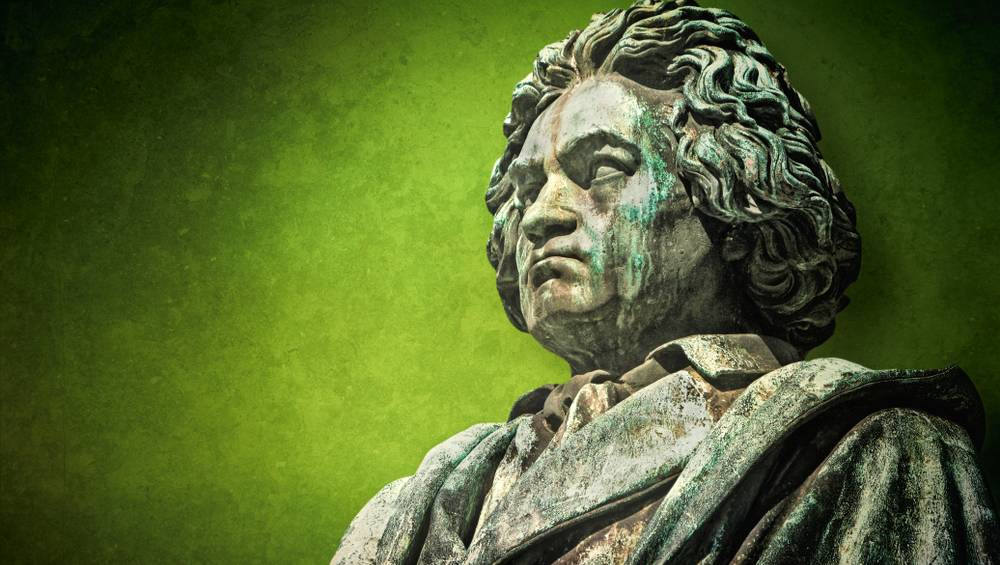news, latest-news, beethoven, deaf, deafness, hearing, ask fuzzy, rod taylor
It’s risky diagnosing historical figures, but most likely Beethoven’s deafness was caused by otosclerosis, which is a thickening of the middle ear bones. Given that his deafness was well known in his day, it seems negligent that his physicians Dr Wagner and Dr Wawruch failed to mention, or even keep these bones after the autopsy they performed. They couldn’t even claim ignorance since Beethoven died over 250 years after the middle ear bones had been described by the Italian anatomist Giovanni Filippo Ingrassia in 1553. Ingrassia was a major figure in his own right. Well before the modern understanding of germ theory, he helped control an outbreak of the plague using public health counter-measures. If Beethoven were alive today and diagnosed with otosclerosis, he could do a lot better than hot baths and herbal remedies that were administered to him. He might be prescribed sodium fluoride which has been found to slow the progression of the disease. He might also have cause to thank the American surgeon John Joseph Shea Jr (1924-2015) who invented the procedure known as stapedectomy, which can largely correct the disease. It’s hard to get a sense of the tiny scale stapedectomy surgeons have to work with. The stapes is the smallest bone in the human body – about 3 x 2.5mm – that’s roughly the size of the letter C on this page. They use a laser to ablate the stapes middle ear bone, then replace it with a prosthesis. Shea’s first patient was a 54-year-old woman. It was remarkably successful given it was the first time this had ever been tried. Imagine what it would’ve been like for Shea and his patient because without any prior cases, it’s hard to predict what can go wrong. Still, she was already near deaf, so perhaps she felt she had nothing to lose. Poor Beethoven didn’t have the benefits of modern medicine or access to hearing aids as we know them, but he did have a primitive precursor. It seems fitting that the eccentric genius would be seen around his home with various oddly shaped brass instruments pressed to his ear. To make these, he engaged the inventor of the metronome, Johann Malzel. In the movie Copying Beethoven (recommended), starring Ed Harris, you can see Beethoven using them. These instruments are now on display in the Beethoven museum in Bonn. Beethoven resorted to pressing his head against the piano. By doing this, he was largely bypassing the middle ear whose job is to conduct sound from the outer ear into the inner ear (the cochlea). Instead, the sound would be transmitted through his skull. If you have hearing problems, visit an audiologist and talk to your local branch of Better Hearing Australia. The Fuzzy Logic Science Show is 11am Sundays on 2xx 98.3FM. Send your questions to [email protected] Twitter @FuzzyLogicSci Podcast FuzzyLogicOn2xx.Podbean.com
/images/transform/v1/crop/frm/Z4Q6sUEHdcmw72MBPYgZkU/162a3977-9197-43f5-b3b9-6d7aeca33e37.jpg/r0_15_1000_580_w1200_h678_fmax.jpg
It’s risky diagnosing historical figures, but most likely Beethoven’s deafness was caused by otosclerosis, which is a thickening of the middle ear bones.
Given that his deafness was well known in his day, it seems negligent that his physicians Dr Wagner and Dr Wawruch failed to mention, or even keep these bones after the autopsy they performed.
They couldn’t even claim ignorance since Beethoven died over 250 years after the middle ear bones had been described by the Italian anatomist Giovanni Filippo Ingrassia in 1553.
Ingrassia was a major figure in his own right. Well before the modern understanding of germ theory, he helped control an outbreak of the plague using public health counter-measures.
If Beethoven were alive today and diagnosed with otosclerosis, he could do a lot better than hot baths and herbal remedies that were administered to him. He might be prescribed sodium fluoride which has been found to slow the progression of the disease.
He might also have cause to thank the American surgeon John Joseph Shea Jr (1924-2015) who invented the procedure known as stapedectomy, which can largely correct the disease.
It’s hard to get a sense of the tiny scale stapedectomy surgeons have to work with. The stapes is the smallest bone in the human body – about 3 x 2.5mm – that’s roughly the size of the letter C on this page.
They use a laser to ablate the stapes middle ear bone, then replace it with a prosthesis.
Shea’s first patient was a 54-year-old woman. It was remarkably successful given it was the first time this had ever been tried. Imagine what it would’ve been like for Shea and his patient because without any prior cases, it’s hard to predict what can go wrong.
Still, she was already near deaf, so perhaps she felt she had nothing to lose.
Poor Beethoven didn’t have the benefits of modern medicine or access to hearing aids as we know them, but he did have a primitive precursor.
It seems fitting that the eccentric genius would be seen around his home with various oddly shaped brass instruments pressed to his ear.
To make these, he engaged the inventor of the metronome, Johann Malzel.
In the movie Copying Beethoven (recommended), starring Ed Harris, you can see Beethoven using them.
These instruments are now on display in the Beethoven museum in Bonn.
Beethoven resorted to pressing his head against the piano. By doing this, he was largely bypassing the middle ear whose job is to conduct sound from the outer ear into the inner ear (the cochlea). Instead, the sound would be transmitted through his skull.
If you have hearing problems, visit an audiologist and talk to your local branch of Better Hearing Australia.
The Fuzzy Logic Science Show is 11am Sundays on 2xx 98.3FM.
Send your questions to [email protected] Twitter @FuzzyLogicSci Podcast FuzzyLogicOn2xx.Podbean.com







